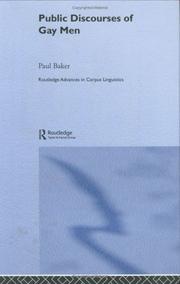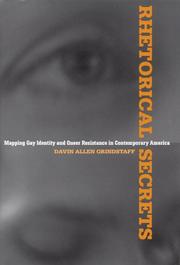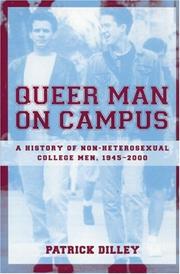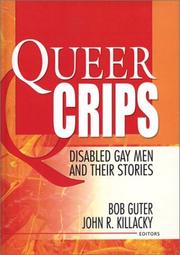| Listing 1 - 10 of 111 | << page >> |
Sort by
|

ISBN: 1134271573 1280377003 9786610377008 0203643534 9780203643532 6610377006 0415349737 9780415349734 9781134271573 9781134271528 1134271522 9781134271566 1134271565 9780415850223 0415850223 9781280377006 Year: 2005 Publisher: London New York Routledge
Abstract | Keywords | Export | Availability | Bookmark
 Loading...
Loading...Choose an application
- Reference Manager
- EndNote
- RefWorks (Direct export to RefWorks)
Queer linguistics has only recently developed as an area of study; however academic interest in this field is rapidly increasing. Despite its growing appeal, many books on 'gay language' focus on private conversation and small communities. As such, Public Discourses of Gay Men represents an important corrective, by investigating a variety of sources in the public domain. A broad range of material, including tabloid newspaper articles, political debates on homosexual law and erotic narratives are used in order to analyse the language surrounding homosexuality. Bringing together quee
Gay men --- English language --- Gays, Male --- Homosexuals, Male --- Male gays --- Male homosexuals --- Urnings --- Gays --- Men --- Germanic languages --- Language. --- Discourse analysis.
Book
Abstract | Keywords | Export | Availability | Bookmark
 Loading...
Loading...Choose an application
- Reference Manager
- EndNote
- RefWorks (Direct export to RefWorks)
Fonds Suzan Daniel (FSD)
Sociology of minorities --- Netherlands --- Gay men --- Male homosexuality --- Homosexuality, Male --- Homosexuality --- Men --- Gays, Male --- Homosexuals, Male --- Male gays --- Urnings --- Gays --- Sexual behavior --- Male homosexuals
Book
ISBN: 1282764160 9786612764165 0299248534 9780299248536 9781282764163 9780299248505 029924850X 6612764163 0299248593 9780299248598 Year: 2010 Publisher: Madison, Wisconsin
Abstract | Keywords | Export | Availability | Bookmark
 Loading...
Loading...Choose an application
- Reference Manager
- EndNote
- RefWorks (Direct export to RefWorks)
Vivacious, unconventional, candid, and straight, Helen Branson operated a gay bar in Los Angeles in the 1950s - America's most anti-gay decade. After years of fending off drunken passes as an entertainer in cocktail bars, this divorced grandmother preferred the wit, variety, and fun she found among homosexual men. Enjoying their companionship and deploring their plight, she gave her gay friends a place to socialize. Though at the time California statutes prohibited homosexuals from gathering in bars, Helen's place was relaxed, suave, and remarkably safe from police raids and other anti-homosexual hazards. In 1957 she published her extraordinary memoir Gay Bar, the first book by a heterosexual to depict the lives of homosexuals with admiration, respect, and love. In this new edition of Gay Bar, Will Fellows interweaves Branson's chapters with historical perspective provided through his own insightful commentary and excerpts gleaned from letters and essays appearing in gay publications of the period. Also included is the original introduction to the book by maverick 1950s psychiatrist Blanche Baker. The eclectic selection of voices gives the flavor of American life in that extraordinary age of anxiety, revealing how gay men saw themselves and their circumstances, and how others perceived them.
Gay men --- Gay bars --- Gays, Male --- Homosexuals, Male --- Male gays --- Male homosexuals --- Urnings --- Gays --- Men --- Bars (Drinking establishments) --- Gay business enterprises --- Social conditions
Book
ISBN: 0674070860 0674067517 9780674067516 9780674066793 0674066790 9780674283992 0674283996 9780674070868 Year: 2012 Publisher: Cambridge, MA
Abstract | Keywords | Export | Availability | Bookmark
 Loading...
Loading...Choose an application
- Reference Manager
- EndNote
- RefWorks (Direct export to RefWorks)
No one raises an eyebrow if you suggest that a guy who arranges his furniture just so, rolls his eyes in exaggerated disbelief, likes techno music or show tunes, and knows all of Bette Davis's best lines by heart might, just possibly, be gay. But if you assert that male homosexuality is a cultural practice, expressive of a unique subjectivity and a distinctive relation to mainstream society, people will immediately protest. Such an idea, they will say, is just a stereotype-ridiculously simplistic, politically irresponsible, and morally suspect. The world acknowledges gay male culture as a fact but denies it as a truth. David Halperin, a pioneer of LGBTQ studies, dares to suggest that gayness is a specific way of being that gay men must learn from one another in order to become who they are. Inspired by the notorious undergraduate course of the same title that Halperin taught at the University of Michigan, provoking cries of outrage from both the right-wing media and the gay press, How To Be Gay traces gay men's cultural difference to the social meaning of style. Far from being deterred by stereotypes, Halperin concludes that the genius of gay culture resides in some of its most despised features: its aestheticism, snobbery, melodrama, adoration of glamour, caricatures of women, and obsession with mothers. The insights, impertinence, and unfazed critical intelligence displayed by gay culture, Halperin argues, have much to offer the heterosexual mainstream.
Gay men. --- Gays. --- Gay people --- Gay persons --- Homosexuals --- Persons --- Gays, Male --- Homosexuals, Male --- Male gays --- Male homosexuals --- Urnings --- Gays --- Men --- Gay culture. --- Gay people.

ISBN: 0817387609 9780817387600 0817315063 9780817315061 Year: 2006 Publisher: Tuscaloosa
Abstract | Keywords | Export | Availability | Bookmark
 Loading...
Loading...Choose an application
- Reference Manager
- EndNote
- RefWorks (Direct export to RefWorks)
Davin Allen Grindstaff, through a series of close textual analyses examining public discourse, uncovers the rhetorical modes of persuasion surrounding the construction of gay male sexual identity. In Part One, Grindstaff establishes his notion of the ""rhetorical secret"" central to constructions of gay male identity: the practice of sexual identity as a secret, its promise of a coherent sexual self, and the perpetuation of secrecy as a product and strategy of heteronormative discourse. Grindstaff continues in Part Two to examine major issues related to contemporary
Rhetoric --- Male homosexuality --- Gay men --- Gays, Male --- Homosexuals, Male --- Male gays --- Male homosexuals --- Urnings --- Gays --- Men --- Language and languages --- Speaking --- Authorship --- Expression --- Literary style --- Social aspects --- Identity.

ISBN: 0415933374 1317973003 1315870541 1317973011 9781317973003 0415933366 9780415933360 9780415933377 9781315870540 9781317972990 9781317973010 Year: 2002 Publisher: New York : RoutledgeFalmer,
Abstract | Keywords | Export | Availability | Bookmark
 Loading...
Loading...Choose an application
- Reference Manager
- EndNote
- RefWorks (Direct export to RefWorks)
This book reveals the inadequacy of a unified ""gay"" identity in studying the lives of queer college men. Instead, seven types of identities are discernible in the lives of non-heterosexual college males, as the author shows.
Gay men --- Gay college students --- Identity (Psychology) --- Gays, Male --- Homosexuals, Male --- Male gays --- Male homosexuals --- Urnings --- Gays --- Men --- College students --- Identity. --- Psychology. --- History

ISBN: 1315783835 1317712692 1317712706 9781317712701 9781560234562 1560234563 9781560234579 1560234571 9781315783833 9781317712688 9781317712695 Year: 2014 Publisher: New York, NY
Abstract | Keywords | Export | Availability | Bookmark
 Loading...
Loading...Choose an application
- Reference Manager
- EndNote
- RefWorks (Direct export to RefWorks)
Get an inside perspective on life as a disabled gay man! Queer Crips: Disabled Gay Men and Their Stories reverberates with the sound of ?cripgay? voices rising to be heard above the din of indifference and bias, oppression and ignorance. This unique collection of compelling first-person narratives is at once assertive, bold, and groundbreaking, filled with characters?and character. Through the intimacy of one-on-one storytelling, gay men with mobility and neuromuscular disorders, spinal cord injury, deafness, blindness, and AIDS, fight isolation from society?and each other?to establis
Gay men --- Gays with disabilities --- Gays --- People with disabilities --- Gays, Male --- Homosexuals, Male --- Male gays --- Male homosexuals --- Urnings --- Men --- Gay people with disabilities
Book
ISBN: 3030737268 303073725X Year: 2021 Publisher: Cham, Switzerland : Springer,
Abstract | Keywords | Export | Availability | Bookmark
 Loading...
Loading...Choose an application
- Reference Manager
- EndNote
- RefWorks (Direct export to RefWorks)
Gay men --- HIV-positive gay men --- Gay HIV-positive men --- HIV-positive men --- Gays, Male --- Homosexuals, Male --- Male gays --- Male homosexuals --- Urnings --- Gays --- Men
Book
ISBN: 1282946064 9786612946066 157344474X Year: 2008 Publisher: San Francisco, Calif. : Cleis Press,
Abstract | Keywords | Export | Availability | Bookmark
 Loading...
Loading...Choose an application
- Reference Manager
- EndNote
- RefWorks (Direct export to RefWorks)
Gay men --- Erotic stories, American. --- Sexual behavior --- American erotic stories --- American fiction --- Gays, Male --- Homosexuals, Male --- Male gays --- Male homosexuals --- Urnings --- Gays --- Men
Book
ISBN: 9051704100 Year: 1997 Publisher: Amsterdam Thesis publ.
Abstract | Keywords | Export | Availability | Bookmark
 Loading...
Loading...Choose an application
- Reference Manager
- EndNote
- RefWorks (Direct export to RefWorks)
Gay men --- -Gay men --- -Homosexuality, Male --- -#PBIB:2001.3 --- homoseksualiteit --- hulpverlening --- seksualiteit --- Homosexuality, Male --- Homosexuality --- Men --- Gays, Male --- Homosexuals, Male --- Male gays --- Urnings --- Gays --- Services for --- -Sexual behavior --- Male homosexuality --- #PBIB:2001.3 --- Male homosexuals --- Sexual behavior
| Listing 1 - 10 of 111 | << page >> |
Sort by
|

 Search
Search Feedback
Feedback About UniCat
About UniCat  Help
Help News
News